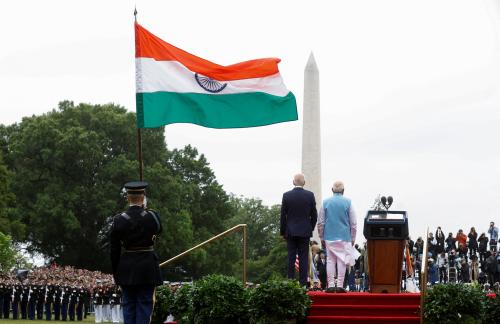Content from the Brookings Institution India Center is now archived. After seven years of an impactful partnership, as of September 11, 2020, Brookings India is now the Centre for Social and Economic Progress, an independent public policy institution based in India.
Narendra Modi government needs to work with several other constituents, including state governments, corporate sector, think tanks and civil society writes WPS SIdhu
At the end of its second year in office, the foreign policy performance of the Narendra Modi government resembles that of a gleaming Ferrari powered by a frugal Ambassador engine. Despite the best efforts of its impatient driver and his eager team instead of racing from victory to victory, it is spluttering to reach its next destination. This is on account of several systemic factors.
Although Modi’s foreign policy team, led by the prime minister himself, has diligently revived engagement at the bilateral, regional and multilateral level, visited almost 130 countries and attended nearly every crucial regional and international summit, the outcomes have been uncertain for a number of reasons.
First, the number of diplomats, despite the recent expansion and re-designation of some officials, remains not only the smallest among the G-20 countries but also the smallest among the BRICS (Brazil, Russia, India, China and South Africa) group. For instance, in Africa (a continent of growing significance for India), over two dozen Indian embassies remain headless for want of diplomats. Similarly at the United Nations, where India is seeking permanent membership of the coveted Security Council, the Indian mission is the smallest among the G-4 (Brazil, Germany, India and Japan) aspirants to the Council. Even Brazil’s mission is three times that of India’s. Consequently, the follow up of political initiatives has remained uneven at best.
Second, given the multifaceted nature of foreign policy initiatives today—which cut across several disciplines and ministries—the inter-agency process becomes vital for its effective implementation. However, inter-agency coordination in India is virtually non-existent, especially when compared to other countries that India is engaging with. Moreover, the smaller size of the foreign service, particularly when compared to the more populous and powerful Indian Administrative Service, means that foreign policy initiatives are often bogged down in bureaucratic wrangles. Not surprisingly then, the only foreign policy initiatives that have been implemented are those that are coordinated by the all-powerful prime minister’s office.
Third, as the world’s 10th largest economy, India is becoming a rich country. But it remains a poor state primarily on account of its extremely small tax base. According to recent income tax data, a mere 1% of all Indians—about 12.5 million—pay taxes (the fewest taxpayers among the G-20 and BRICS nations). This in turn affects New Delhi’s ability to have a more proactive foreign policy. Thus, while India merely negotiates, China (with a huge trade surplus) invests in countries of strategic importance.
While addressing these systemic factors will go a long way in empowering the foreign policy establishment to follow through on political initiatives, that alone will not be enough for India to play a more prominent global role. Along with resolving these systemic factors, India also needs to articulate a strategic vision for its foreign policy. Presently, instead of an overarching Modi doctrine, there are a series of catchy but vacuous foreign policy initiatives, such as Neighbourhood First, Act East, Think West and SAGAR. Sadly, these parts still do not add up to the sum of India’s foreign policy.
To be fair, the complex and chaotic geopolitical scenario confronting India (and every other major power) does not lend itself to easy analysis or response. Nor is the government alone well-equipped to evaluate the challenges and opportunities that the unfolding geopolitical landscape presents.
To develop such a national vision, the Modi government needs to work with several other constituents, including state governments, the corporate sector, think tanks and civil society. While the government has articulated the need to engage with all these key domestic actors, it has still not put it into practice.
Such an approach is vital if India’s foreign policy is to look and drive like a Ferrari.
This article first appeared in Mint on May 9, 2016. Like other products of the Brookings Institution India Center, this is intended to contribute to discussion and stimulate debate on important issues. The views are those of the author.



Commentary
Op-edIndia’s underpowered foreign policy
Mint
May 9, 2016